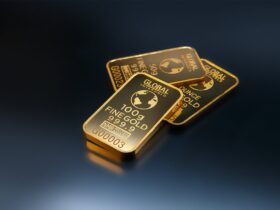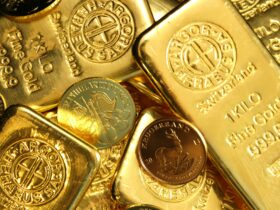Silver’s Sudden Slide After a Spectacular Rally
After weeks of breathtaking gains, silver prices have taken a sharp turn, dropping over 6% in their steepest fall in half a year. The correction comes after an intense rally that saw silver approach $54.50 per ounce, driven by a mix of speculative buying, industrial demand, and global economic uncertainty.
But as market sentiment shifted — with credit risks easing in the U.S. and trade tensions between Washington and Beijing showing signs of thawing — investors began locking in profits. The move has caused a ripple effect across the entire precious metals complex, including gold, platinum, and palladium, which also saw declines.
Silver’s Correction: A Natural Pause in a Rapid Rally
Silver’s sharp drop followed what many analysts are calling an overheated market rally. The metal’s surge in recent weeks was fueled by strong demand from both institutional investors and industrial buyers, particularly those linked to renewable energy and electronics manufacturing.
However, such rapid price acceleration often triggers a short-term pullback. According to traders, silver’s Relative Strength Index (RSI) — a measure of momentum — signaled “overbought” conditions since late September, suggesting the rally may have run too far, too fast.
By Friday, silver prices reversed sharply, reflecting both profit-taking and a normalization of supply conditions in key global markets.
Credit and Trade Tensions Ease, Weakening Safe-Haven Demand
One of the biggest factors behind silver’s recent retreat is the improvement in investor sentiment. Over the past week, concerns about U.S. credit quality and global trade frictions have eased significantly.
Comments from President Donald Trump on Friday helped cool anxiety surrounding trade talks with China, reducing the perceived need for safe-haven assets like gold and silver. Meanwhile, strong earnings from U.S. regional banks bolstered confidence in the broader financial system, stabilizing stock markets and pushing bond yields higher.
Higher interest rates tend to hurt non-yielding assets like precious metals because they increase the opportunity cost of holding them. As yields rise, investors often rotate back into income-generating securities, reducing the appeal of metals that don’t pay dividends or interest.
The London Silver Squeeze Begins to Ease
Another major factor contributing to silver’s decline is the unwinding of a historic supply squeeze in the London bullion market. For much of the past two weeks, tight supply conditions pushed London silver prices far above those in New York, prompting traders to fly metal across the Atlantic to meet demand.
According to Nicky Shiels, head of metals strategy at MKS Pamp SA, “The London shortage is alleviating somewhat from extreme levels, and as regional dislocations smooth out, there could be pressure and profit-taking.”
As logistical bottlenecks ease and physical silver begins to flow back into the market, prices are normalizing. The gap between London and New York silver prices, once as wide as $3 per ounce, has now narrowed to around $1.10 — still elevated but significantly lower than last week’s extremes.
Massive Outflows and Warehouse Movements Signal Stabilization
Recent data from the Comex futures exchange shows that more than 15 million ounces of silver were withdrawn from New York warehouses in the past week. Much of this metal is believed to be headed for London, where demand had spiked amid tight supply conditions.
Additionally, silver-backed exchange-traded funds (ETFs) recorded a massive 10 million-ounce outflow on Thursday, signaling that investors are beginning to take profits after the recent surge.
While these movements might seem bearish on the surface, they actually help rebalance global supply chains, easing stress in the London market and paving the way for more sustainable pricing.
Gold Follows Silver Lower, But Outlook Remains Bullish
Silver wasn’t alone in its retreat. Gold, which had surged more than 60% this year, also declined slightly as investors rotated into riskier assets. The correction in gold comes after a powerful rally supported by central-bank buying, ETF inflows, and growing bets on U.S. interest rate cuts later this year.
Analysts note that gold’s decline is likely temporary, with macroeconomic uncertainty and geopolitical risks continuing to provide a strong foundation for long-term demand. Many expect both gold and silver to remain resilient despite short-term corrections, especially if the U.S. Federal Reserve adopts a more accommodative policy stance.
Profit-Taking and Market Psychology: A Classic Correction
Markets rarely move in straight lines, and silver’s latest pullback fits a familiar pattern. When prices rise too quickly, traders who entered early tend to lock in gains, triggering a wave of selling that amplifies price declines.
This behavior, combined with easing physical shortages and shifting macroeconomic dynamics, creates a short-term correction that often resets momentum before the next leg higher.
Analysts view this as a healthy sign rather than a collapse, arguing that silver’s long-term fundamentals remain intact. The metal’s critical role in green technologies, including solar panels, electric vehicles, and advanced electronics, continues to support robust underlying demand.
Silver’s Broader Role: From Industrial Metal to Safe Haven
What makes silver unique in the commodities landscape is its dual identity — it functions both as an industrial metal and as a precious asset. This dual nature means its price is influenced by both economic growth trends and investor sentiment toward safe havens.
In 2025, silver demand has been particularly strong from the renewable energy sector, where it is essential in photovoltaic cells for solar panels. Additionally, the electronics and automotive industries are increasingly reliant on silver for its superior conductivity and durability.
At the same time, macroeconomic uncertainty — from inflation fears to currency devaluation — has kept silver in the spotlight for investors seeking portfolio diversification.
What’s Next for Silver Prices?
Looking ahead, the question on every investor’s mind is whether silver’s drop marks the end of the rally or simply a pause.
Several key factors will determine its trajectory:
- Global interest rate policy: If central banks move toward rate cuts, silver could regain momentum.
- U.S.-China trade relations: Renewed friction could reignite safe-haven demand.
- Industrial demand recovery: Growth in green technologies could provide long-term support.
- Physical market balance: The easing of the London squeeze may stabilize prices but also reduce speculative premiums.
Analysts generally expect silver to stabilize around the $50–52 range before potentially testing higher levels later this year, especially if macroeconomic conditions turn more favorable.
A Cooling Phase in a Long-Term Bull Market
Silver’s 6% plunge may seem alarming, but in the grand scheme, it’s a healthy correction following an extraordinary rally. The easing of market tightness in London, reduced safe-haven demand, and profit-taking behavior all point to a natural consolidation phase rather than a full-blown reversal.
With strong industrial demand and potential monetary policy shifts on the horizon, silver’s long-term fundamentals remain bright. Investors who view this dip as a temporary cooldown — not a crash — may find new opportunities to enter the market before the next potential upswing.
As history often reminds us, in the world of precious metals, every pullback is just another step in the climb toward the next high.







Leave a Reply